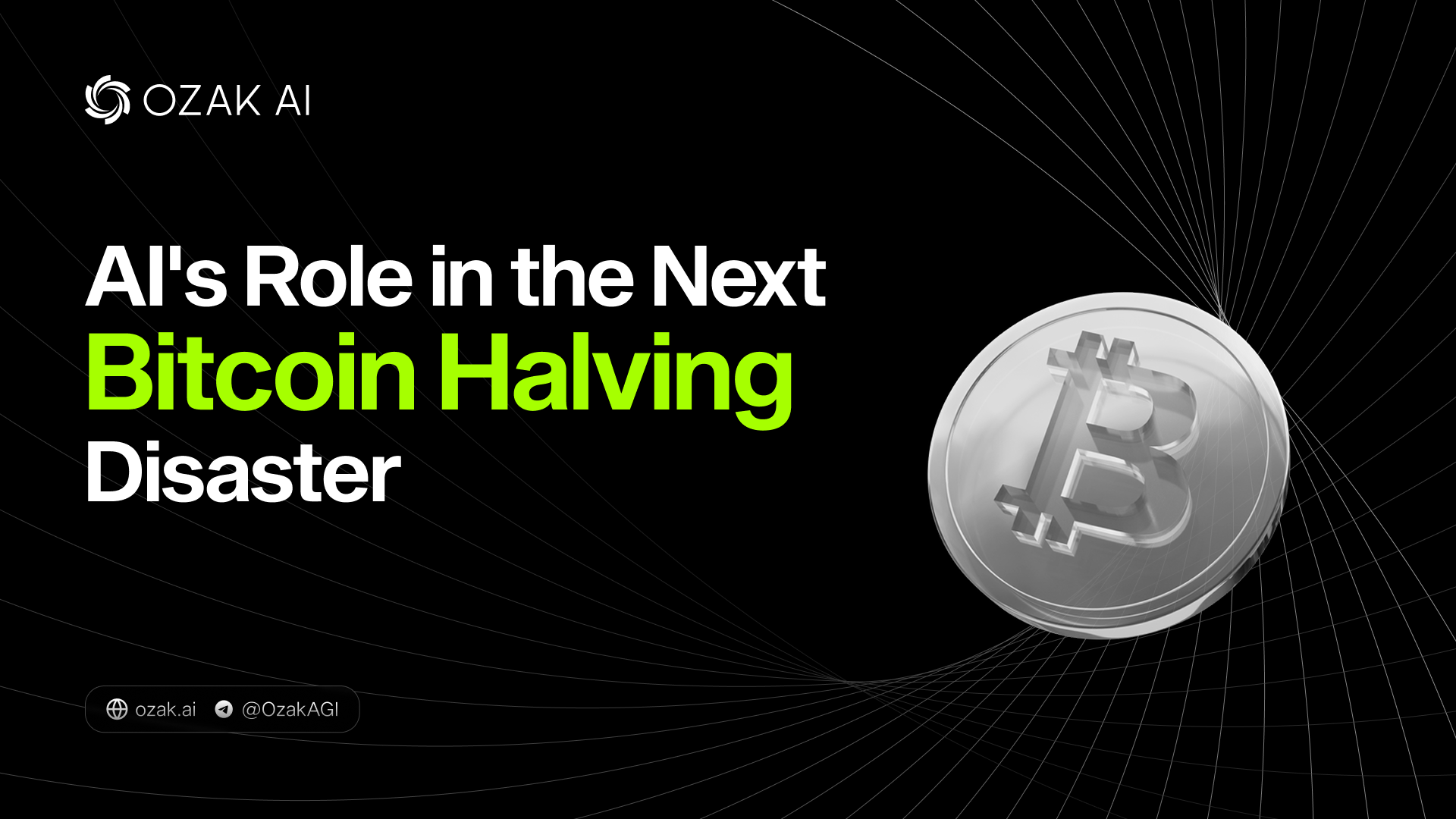
The Fatal Flaws in Kaito AI's Model
It's August 8, 2025, and Kaito AI drops what they call a "major upgrade" to their leaderboards, promising to slash spam, crush AI-generated slop, and elevate "authentic" creators in the crypto space.
Sounds revolutionary, doesn’t it? But within days, Crypto Twitter erupts in chaos - small creators cry foul as their rankings plummet overnight, accused of "farming" simply for focusing on niche projects like Monad, while multi-topic influencers with questionable engagement soar to the top.
One frustrated user laments how the new algorithm seems to punish dedicated "single-project yappers," turning what was meant to democratize attention into an elitist echo chamber. Others point to leaderboards now flooded with "shitposters," questioning if this "fix" is just amplifying noise instead of cutting it.
Is Kaito AI truly pioneering a fairer crypto intelligence era, or is it rigging the game for the inner circle and risking a total breakdown of trust in 2025's attention economy?
Let’s expose the hidden cracks that could shatter this hyped AI-crypto hybrid before it even peaks.
Key Concepts:
>>>>> Farming here means tricking the system to get rewards without doing real work, like using fake accounts or bots to boost your score. It's not about actual farms - think of it as "gaming the game" to earn points unfairly
>>>>> Yappers are people who create and share content on social media about crypto, like bloggers or tweeters. They're called yappers because they "yap" or talk a lot to build attention and get rewards.
Understanding Kaito AI: The Promise vs. Reality
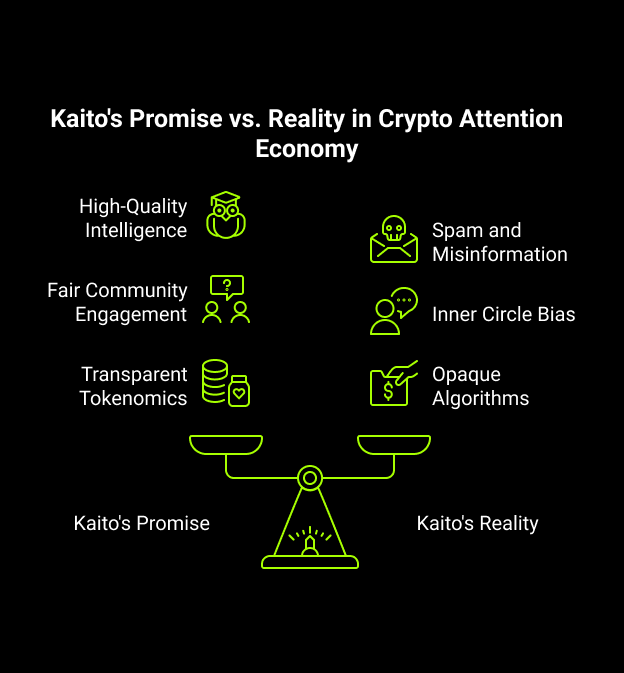
Understanding Kaito AI: The Promise vs. Reality
At its core, Kaito AI burst onto the scene in early 2025 as a groundbreaking AI-powered platform designed to revolutionize the Web3 information landscape, often dubbed an "InfoFi" network.
Launched with much fanfare on February 14, 2025, alongside its native $KAITO token, the platform promised to transform the chaotic crypto attention economy by aggregating vast amounts of data from social media, forums, and on-chain sources into actionable, real-time insights.
Think of it as a supercharged search engine for crypto: using advanced AI to index, structure, and analyze market sentiment, narratives, and trends, all while rewarding users for their engagement through a tokenized system called Yaps.
The vision was bold - democratizing access to high-quality intelligence, where attention itself becomes a tradable asset, cutting out Web2 middlemen and empowering creators, projects, and investors alike.
Proponents hailed it as the missing link in crypto's evolution, blending AI with blockchain to create a fairer, more efficient ecosystem where value flows directly to those generating real mindshare.
On paper, the promise is intoxicating. Kaito's AI-driven tools, like its Pro search engine, pull from terabytes of Web3 data to deliver nuanced analytics - audience breakdowns, sentiment tracking, and even predictive narratives - helping retail traders, institutions, and projects navigate the noise of Crypto Twitter.
Through integrations like Bittensor for enhanced natural language processing, it aims to decentralize not just computation but decision-making itself, rewarding "yappers" (content creators) with tokens for sharing insights and building communities. Early adopters raved about how it quantified attention in ways Web2 platforms couldn't, turning likes, shares, and impressions into measurable, monetizable currency.
Projects could launch targeted campaigns, allocate tokens based on genuine engagement, and foster organic growth without relying on paid influencers or ads. In a 2025 market buzzing with AI hype and recovering from previous cycles, Kaito positioned itself as the protocol-level solution to crypto's information overload, with deflationary tokenomics and leaderboards promising transparent meritocracy.
But fast-forward to mid-2025, and the reality paints a starkly different picture. While Kaito has undeniably shifted how projects approach marketing - evidenced by its rapid adoption and partnerships like those with Union and Skate Chain - the platform's execution has been plagued by inconsistencies that undermine its lofty goals. Users and critics alike point to a growing disconnect: instead of fostering quality-driven attention, the system often rewards sheer volume and network effects, creating an environment ripe for spam, misinformation, and exploitation.
Recent upgrades, intended to curb AI-generated "slop" and bot farming, have instead sparked backlash for punishing niche creators while favoring established influencers in Crypto Twitter's "inner circle."
What started as a tool to decentralize intelligence now feels, to many, like another centralized gatekeeper, where opaque algorithms dictate visibility and rewards, echoing the very Web2 pitfalls it vowed to fix.
As we'll explore, these gaps aren't just minor hiccups - they're systemic flaws threatening to implode the attention economy Kaito sought to build.
Key Concepts:
>>>>> InfoFi is short for "Information Finance" - it's like turning knowledge and data into money using crypto tools. Think of it as a system where sharing info earns you tokens, blending news with finance.
>>>>> Deflationary tokenomics means the rules for a coin make it rarer over time, like burning some coins to increase value. It's like limited-edition collectibles that get more expensive as fewer exist.
Flaw 1: Gamification and Easy Exploitation - Turning Rewards into a Scam

Flaw 1: Gamification and Easy Exploitation - Turning Rewards into a Scam
One of the most glaring vulnerabilities in Kaito's model lies in its gamified reward system, which, while intended to incentivize meaningful contributions, has instead opened the floodgates to exploitation and turned the platform into a breeding ground for scams.
At the heart of this is the Yap mechanism - a tokenized reward for user engagement, where creators earn points (and eventually tokens) based on their "mindshare" metrics like impressions, likes, and shares.
The idea is simple: post insightful content, build genuine communities, and get compensated. But in practice, this has devolved into a race for quantity over quality, where bad actors game the system through bot farms, tag spamming, and low-effort "shitposting" to inflate scores without adding real value.
Take the August 2025 leaderboard upgrade as a prime example. Kaito introduced stricter filters to combat "AI slop" and farming, such as excluding certain tags and replies from scoring. Yet, far from solving the issue, it exacerbated it: savvy exploiters quickly adapted by shifting to multi-topic posts or using off-chain vote sales to boost engagement artificially.
Projects, desperate for visibility, are shelling out hefty fees - up to $150K in some cases - for "mindshare" campaigns that often result in a deluge of mindless interactions rather than authentic buzz. Critics on X have highlighted how this turns Kaito into a "pay-to-play" scam, where wealthier entities dominate leaderboards, sidelining organic creators and eroding trust in the entire attention economy.
The exploitation runs deeper with sybil attacks, where users create multiple accounts to self-boost or manipulate rankings, a problem Kaito's anti-farming measures - like potential slashing - have failed to fully address.
For instance, cases like 0G Labs controversially topping leaderboards despite questionable mindshare have fueled accusations of rigged mechanics, where gamification rewards not innovation but manipulation tactics. This flaw doesn't just dilute content quality; it risks turning Kaito into a scam vector, where investors chase hyped rankings only to find them built on sand, potentially leading to a broader loss of faith in AI-crypto hybrids as 2025's bull market heats up.
In essence, by making rewards too easy to game, Kaito has inadvertently created a system that prioritizes short-term exploits over long-term value, threatening to scam the very community it claims to empower.
Key Concepts:
A sybil attack is when one person pretends to be many by creating fake accounts. It's like voting multiple times in an election to rig the results.
Slashing is a punishment in crypto where you lose some of your tokens for breaking rules, like a fine. It's meant to stop bad behavior but doesn't always work perfectly.
Flaw 2: Inner Circle Bias and Lack of Transparency - An Elitist Echo Chamber
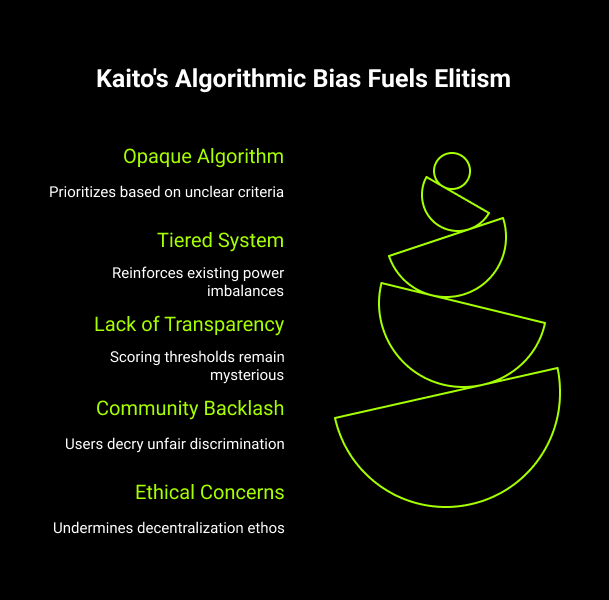
Flaw 2: Inner Circle Bias and Lack of Transparency - An Elitist Echo Chamber
Compounding the gamification issues is Kaito's deeply entrenched bias toward Crypto Twitter's "inner circle," a select group of influential users with established "smart followers" and high mindshare, which effectively turns the platform into an elitist echo chamber that marginalizes smaller creators and diverse voices.
This favoritism is baked into the algorithm, which prioritizes accounts based on opaque criteria like follower quality and historical engagement, often disadvantaging niche or emerging yappers who lack connections to the crypto elite.
For example, the tiered system - Yapper, Emerging CT, and Inner Circle CT - categorizes users by influence, but critics argue it reinforces inequalities by rewarding those already in power while suppressing newcomers.
The lack of transparency exacerbates this problem: scoring thresholds for Yaps and leaderboards remain shrouded in mystery, with sudden rule changes - like the August 2025 update removing replies from rankings - wiping out legitimate players without clear warnings or explanations.
Community backlash has been fierce, with users decrying how the algorithm "almost eliminates all small accounts" and favors those with "large mindshare and smart accounts," deeming it unfair and discriminatory.
One prominent complaint highlights how non-reputable accounts (those without enough "smart followers") are segregated, with the system pitting "Inner CT vs. Emerging CT" and punishing dedicated creators for not aligning with multi-project spamming tactics. Even accusations of regional bias have surfaced, with claims that the algo "favours KOLs and asian people," leading to calls for boycotts.
This opacity not only breeds frustration - evident in posts lamenting how loyal, single-project yappers drop in rankings while low-value influencers persist - but also undermines Kaito's decentralization ethos.
Broader ethical concerns echo industry-wide debates on AI transparency, where "black box" decisions amplify biases and hinder accountability. By failing to provide clear manuals or criteria for earning Yaps, Kaito leaves 99.99% of users in the dark, fostering an environment where the inner circle thrives at the expense of true meritocracy.
Ultimately, this flaw risks alienating the broader community, turning what could be a vibrant, inclusive attention economy into a closed club for the privileged few.
Flaw 3: Inability to Distinguish Signal from Noise - Fueling Misinformation and Chaos
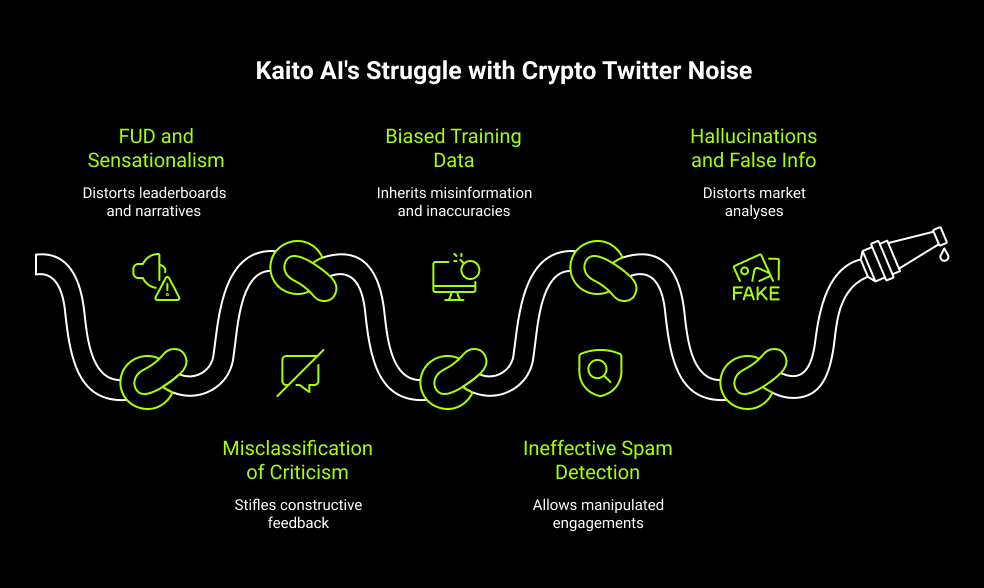
Flaw 3: Inability to Distinguish Signal from Noise - Fueling Misinformation and Chaos
Perhaps the most insidious flaw in Kaito AI's model is its persistent struggle to reliably separate valuable insights from the deluge of misinformation, hype, and low-quality noise that plagues Crypto Twitter.
Powered by large language models (LLMs), the platform's AI is tasked with evaluating content for originality, value, and depth to assign Yap points and mindshare rankings. However, in practice, this often falls short, allowing exploitative tactics like spreading fear, uncertainty, and doubt (FUD) or farming engagement with sensational topics to dominate leaderboards.
Critics have noted how pointing out legitimate project flaws can be misclassified as FUD, causing creators' mindshare to drop and stifling constructive discourse. This not only discourages honest feedback but also amplifies biased narratives, as the algorithm inherits flaws from its training data, including misinformation and cultural insensitivities that lead to regional inaccuracies in scoring.
Real-world examples abound: despite efforts to curb "AI slop" and spam, leaderboards continue to feature accounts with zero substantive posts yet inflated mindshare, possibly through sybil attacks or manipulated engagements that the system fails to detect effectively.
Users have called out how low-effort "shitposters" and multi-topic spammers thrive, while niche experts get buried, turning the attention economy into a chaotic echo of hype over substance. Broader ethical risks compound this, as AI hallucinations - where models generate or perpetuate false information - can distort market analyses, especially in volatile 2025 crypto landscapes where misinformation spreads rapidly via deepfakes or biased datasets.
If Kaito processes flawed inputs, it risks outputting unreliable insights, fueling scams and market manipulations that erode user trust. In an era where AI bias and misinformation are top concerns, this inability to enforce "signal > noise" threatens to transform Kaito from a revolutionary tool into a vector for chaos, undermining the very InfoFi ecosystem it aims to build.
The Community Backlash: Voices from the Frontlines
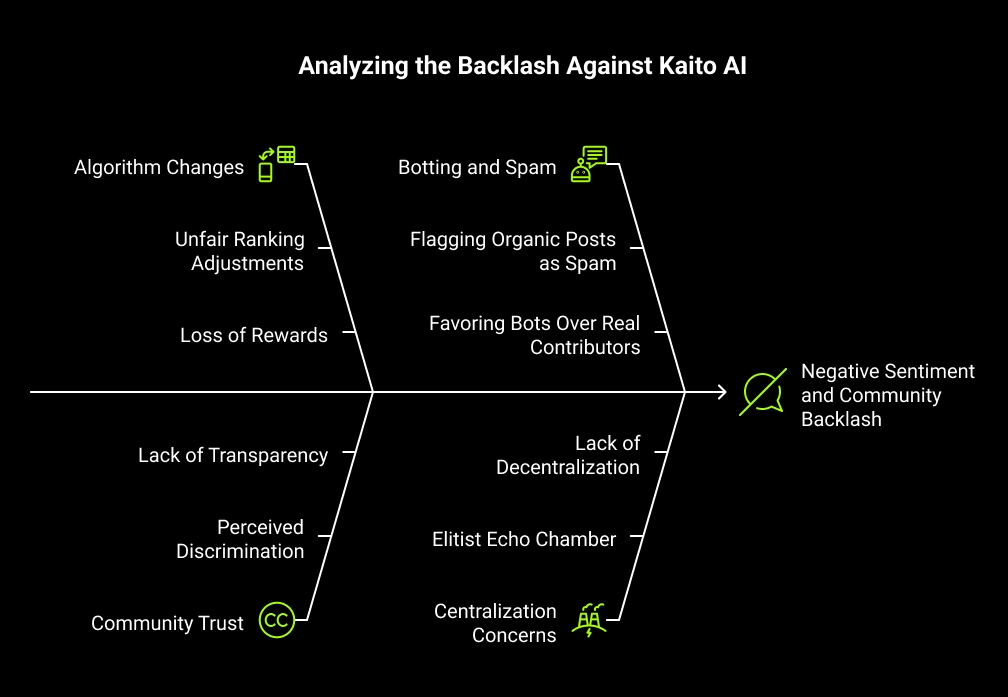
The Community Backlash: Voices from the Frontlines
The August 2025 leaderboard upgrades didn't just tweak algorithms - they ignited a firestorm across Crypto Twitter, with hundreds of posts decrying Kaito AI as unfair, opaque, and detrimental to small creators.
Negative sentiment spiked dramatically, evidenced by threads garnering thousands of views and replies, as users shared stories of plummeting rankings and lost rewards right before monthly airdrops.
One creator vented frustration over being flagged as "spam" for organic posts tagging multiple projects, warning that the "dark side of algorithm" tanks rankings indiscriminately. Another highlighted the irony: "The update replaced real contributors with accounts that never brought any real value," questioning if this erodes community trust and shifts rewards unfairly.
Voices from emerging yappers were particularly vocal, with one lamenting how the changes "almost eliminates all small accounts" and favors "large mindshare and smart accounts," labeling it discriminatory and calling for boycotts amid rumors of regional biases.
A programmer-turned-critic blasted the rollout as "pure negligence," arguing that pushing core contributors off leaderboards in favor of bots and "Inner CT" groups rewards impressions over substance, with no gradual implementation to soften the blow.
Counterarguments exist, with some defending the changes as essential to combat industrial farming and bots, noting that "updates are important" to evaluate fairness and that the algorithm needs time to stabilize.
Kaito's community lead pushed back against blame, emphasizing that botting is a broader social media issue, not unique to the platform, and that ongoing fixes aim to improve the experience.
Yet, this hasn't quelled the debate: Critics argue these defenses ignore the human cost, with one user predicting a "shift in reputation" toward viewing Kaito as a "big account farming tool," potentially driving users to competitors like Wallchain or Cookie.
At its core, the backlash questions Kaito's Web3 credentials - is it a decentralized meritocracy or a centralized cabal protecting elites? The community's divided voices highlight a pivotal moment for the platform in 2025's evolving InfoFi landscape.
Implications and Potential Fixes: Can Kaito Be Salvaged?
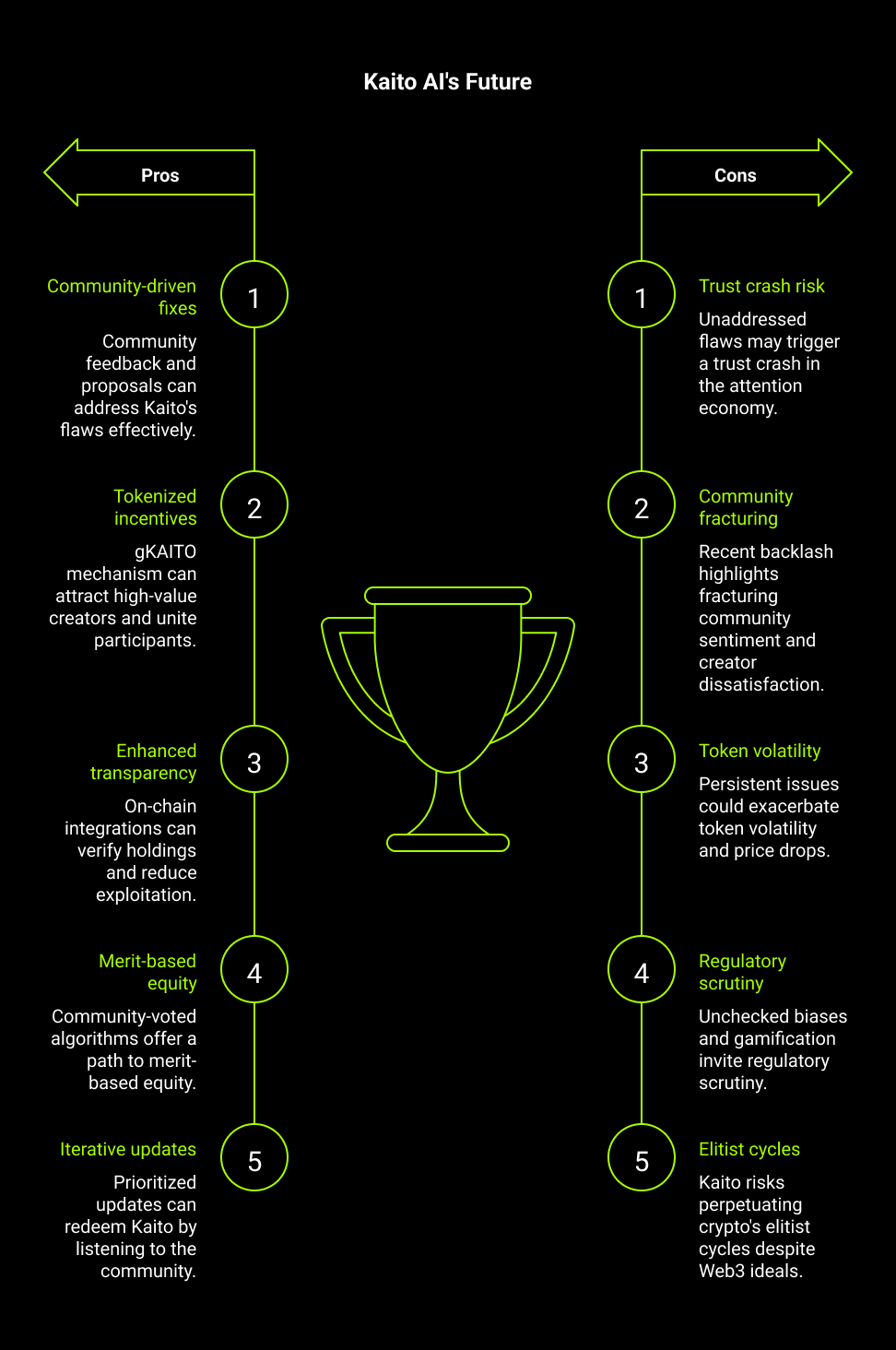
Implications and Potential Fixes: Can Kaito Be Salvaged?
If these flaws remain unaddressed, the implications for Kaito AI could be catastrophic, potentially triggering a "trust crash" in the 2025 attention economy that drives users to competitors like Wallchain or Cookie and tanks the $KAITO token value amid ongoing drama.
Recent backlash from the August 8 upgrade has already highlighted fracturing community sentiment, with small creators feeling sidelined and leaderboards perceived as favoring established influencers or multi-project spammers, leading to accusations of an unsustainable system.
As seen in earlier controversies, such as the June 2025 algorithm tweaks responding to manipulated engagement, persistent issues could exacerbate token volatility - analysts predict $KAITO might retest lows around $0.67 if market confidence erodes further in a recovering bull cycle.
Broader AI-crypto hybrids face similar risks, where unchecked biases and gamification not only dilute platform utility but also invite regulatory scrutiny, mirroring industry-wide failures in data quality and misinformation control.
Yet, Kaito shows promise for salvage through targeted fixes outlined in their roadmap and community feedback. Key proposals include the upcoming gKAITO mechanism to unite participants and attract high-value creators via tokenized incentives, alongside self-alignment tools for signaling focused project loyalty - addressing single-project yapper penalties.
Enhanced AI detection for slop, recategorization of smart followers to eliminate follow-for-follow schemes, and on-chain integrations for verifying holdings and activity could bolster transparency and reduce exploitation.
Community-voted algorithms and project-specific customizations, as Kaito is already collaborating on (e.g., with Cysic for leaderboard tweaks), offer a path to merit-based equity. Broader suggestions from users include real-time adaptive scoring, clear graduation paths between tiers, and quality-weighted engagement metrics to protect genuine growth without rigid cutoffs.
The provocative question lingers: Could blockchain-powered audits or fully open-source models truly "unbreak" Kaito, democratizing its black-box AI and aligning it with Web3's permissionless ideals, or is it doomed to perpetuate crypto's elitist cycles?
With iterative updates prioritized, 2025 could mark Kaito's redemption - if it listens to the frontlines.
Conclusion: A Wake-Up Call for the AI-Crypto Frontier
In dissecting Kaito AI's model, we've uncovered flaws - from gamification exploits and inner circle biases to signal-noise confusion - that aren't isolated bugs but symptoms of a deeper clash: AI's opaque, black-box decision-making colliding with crypto's promise of permissionless, decentralized innovation.
These issues highlight a critical tension in the AI-crypto frontier, where hype often outpaces ethical safeguards, risking misinformation, inequality, and eroded trust in platforms meant to empower users.
As 2025 unfolds with intensifying bull runs and regulatory eyes on Web3, ignoring such vulnerabilities could spell disaster not just for Kaito but for the broader ecosystem blending AI and blockchain.
For investors, creators, and projects, this is a wake-up call to demand more: push for transparent governance, engage in Kaito's community forums to advocate for fixes like open-source algorithms, or pivot to alternatives that prioritize true meritocracy.
The power lies in collective action - whether through feedback loops or exploring rivals - to shape a fairer InfoFi landscape.
